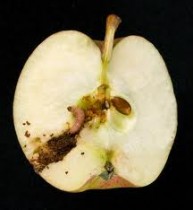Wally Richards: Controlling Codlin moth
Codlin moth (or Codling moth) in fruit such as apples can be a problem for many gardeners who still like growing their own.
I wonder if the growing of apple trees is still as popular as it was many years back. The early settlers were very keen apple tree growers and they had an amazing range of varieties some of which are still available as heirlooms. The reason that early settlers favoured apples was because they could be stored easily for winter use.
 Gardeners often contact me to say they have an old apple tree on their property which has lovely apples but is often ruined by codlin moth grubs.
Gardeners often contact me to say they have an old apple tree on their property which has lovely apples but is often ruined by codlin moth grubs.
There are several methods that can be employed to control the problem but often gardeners not familiar with them get them mixed up and apply the right methods at the wrong time.
In my book, Wallys Green Tips For Gardeners, I wrote the following about the subject:
Codlin moths attack apples, pears, walnuts, quinces, crab apples and stone fruit such as plums and peaches. The females lay their eggs on the foliage near a young fruit and when the grub hatches it crawls to the fruit and eats its way inside. Once inside it is very hard to control.
After a period of time of feeding it emerges and forms a cocoon in the loose bark or under the tree where it will winter over to emerge as a moth in the spring/summer and start the cycle again. A female moth can lay up to 300 eggs during her short life.
There are numerous ways to control the pest and for bad infestations it is worth using several of them.
The interesting thing is that you can have an apple tree and never have the problem. This will be the case if you plant a tree in a situation which is of a good distance from any other infected tree/area. The only chance of a non infected tree becoming infected is to have a female blown in from an infected area.
Hint: Place a tin partly filled with treacle in each infected tree early in the season when the tree starts to flower. Top up the treacle as need be. The best way is to place the tin in an onion bag and hang from a branch at a height where you can easily monitor it. The treacle gives off a pheromone smell similar to the female codlin moth and attracts the males where they will come to a sticky end.
This achieves two aspects; if all the males are caught then they cannot fertilise the females and dud eggs will be laid. Secondly by monitoring the treacle every few days you will be able to determine when the moths are on the wing and take further action. Once a number of male moths are noticed, spray the young apples with Neem Tree Oil about every 7 days till activity in the tins stops.
Some gardeners have also informed me that the scattering of Neem Tree Granules under the apple tree at the very beginning of the season has reduced damage considerably. The granules need further applications about every 4 to 6 weeks till activity has finished for the season. I think its the smell of the Neem Granules that works in this case.
Older methods include; wrapping corrugated cardboard around the trunk of the tree and on main branches in summer which the emerged grubs can crawl to pupate and winter over. New types of corrugated cardboard like products are not so suitable. The down side of this is that some grubs will not crawl down the tree, instead drop to the ground on a silken thread. The cardboard is removed in winter and burnt. Placing grease bands around the trunk to catch and stick the moths crawling up the tree in the spring/summer period. The sticky band has to be one that stays sticky and currently I don’t think there is one on the market that does that. Not all moths will climb the tree and a number will fly up so once again not foolproof.
If you have chickens then in the winter let them free range under the affected trees so that they can scratch out and eat the cocoons in the soil.
Pheromone traps with sticky pads are sold by garden centres to do the same job as the tin of treacle does.
If you clean up all the codlin moths from on and under an infected tree then you will be free of the problem till re-infestation occurs from elsewhere. Another possible control would be Professor’s Macs 3 in 1 as a soil drench applied in winter to zap the pests in the soil while in their winter state.
While listening to Radio Live a lady rang in with the following recipe.
1 ltr warm water
100g sugar
1 tsp marmite
1/2 Tbsp cloudy ammonia
1/2 Tbsp vanilla
Mix well and divide between 2 plastic milk or soft drink bottles. Punch holes just above the level of the mix and hang in tree. The person reporting it said: I did this just as the tree was starting to flower and am amazed to see the bottles full of the darned things.
Now would be the right time to sprinkle Neem Granules under the tree from the trunk to the drip line. When the tree has just about finished flowering use the treacle or other recipe as a trap. Then when activity is noted spraying can commence.

